20 Employee Engagement Survey Questions: The Ultimate Guide

Ever wonder what makes your team tick?
It’s all about asking the right questions—and listening.
This guide will help you unlock the top employee engagement questions for 2025.
Thanks to our study with Freie Universität Berlin, we’ve crafted questions that really get to what motivates employees.
Here’s a sneak peek of what you’ll learn:
- The essence of employee engagement and its business impact
- The must-ask employee engagement questions to get your team talking
- Step-by-step guidance on rolling out an impactful employee engagement survey
What is Employee Engagement?
Employee engagement measures how enthusiastic your employees are about their work and the company.
Essentially, it’s about creating an environment where your teams feel valued and motivated to give their best every day.
At the end of the day, boosting employee engagement leads to high-performing teams and a thriving organization.
Why Do You Need Employee Engagement Surveys?
Did you know?
According to Gallup’s 2023 report, low engagement costs the global economy a staggering $8.8 trillion.
That’s 9% of global GDP.
Improving employee engagement isn’t just a nice-to-have; it’s an absolute must-have.
Here’s how implementing employee engagement surveys can benefit your business:
- Boost performance
Engaged employees often outperform their less engaged peers. Surveys can pinpoint where your team is at and how to boost their morale.
For example, you might find out that your team values flexible work options, leading you to implement a hybrid work model and boost productivity.
- Enhance retention
Identifying what keeps your employees happy or what’s lacking can prevent high churn rates.
For instance, an employee survey might reveal a desire for more professional development, prompting you to create tailored training programs.
- Promote open communication
Surveys help you collect honest feedback, bridging the gap between staff and management.
For example, you might uncover a need for a better feedback system and start organizing regular forums for your employees.
How to Design Effective Employee Engagement Survey Questions
Diving into employee engagement means getting your survey questions right.
We’ve teamed up with Freie Universität Berlin to create a set of questions that cut to the chase of what truly matters at work.
Our method is based on the Job-Demands-Resources model, which ensures a comprehensive and credible approach to measuring engagement.
This model checks how work demands stack up against the resources employees have and how this balance affects their engagement at work.
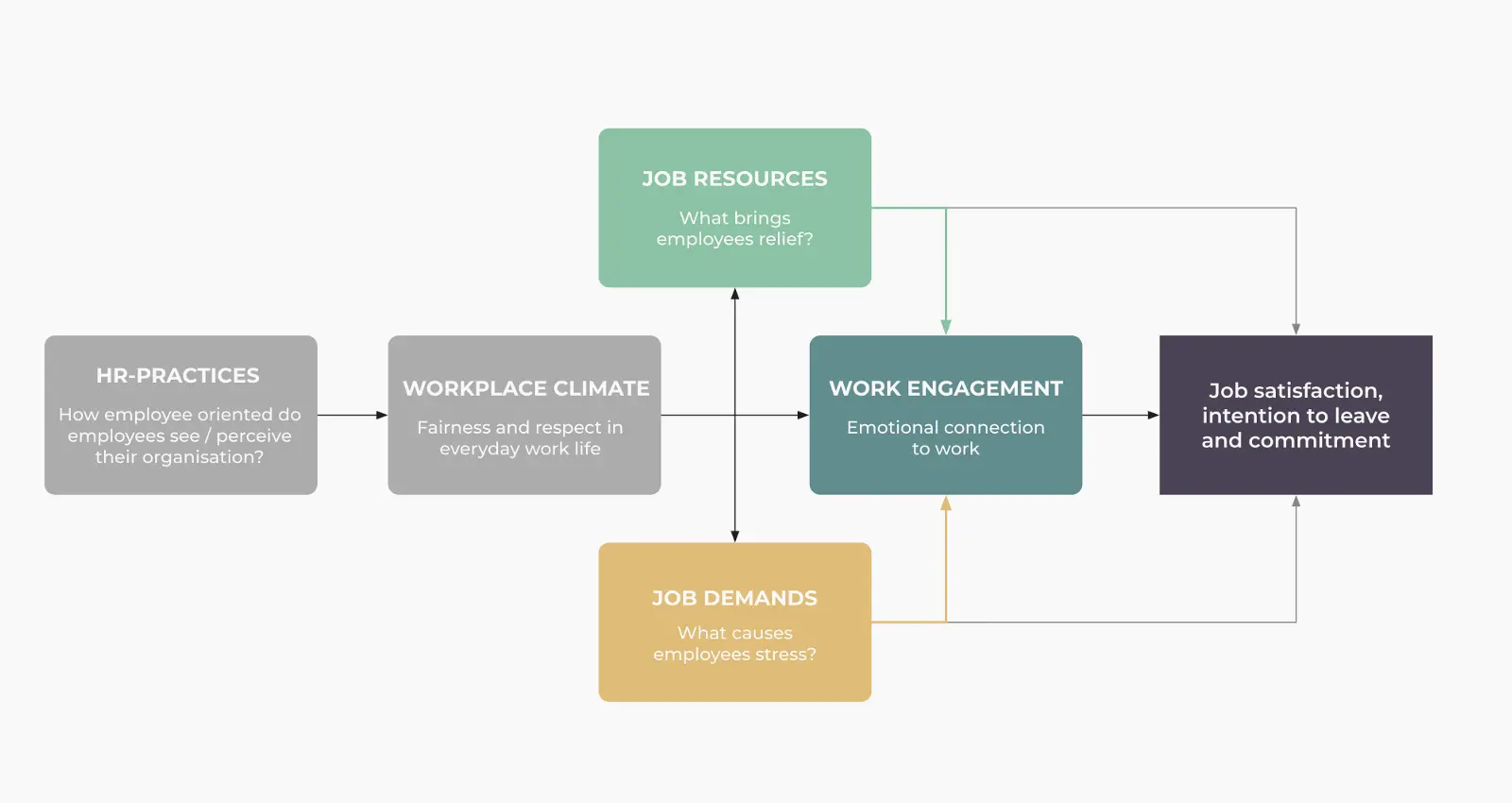
So, when you’re putting together your employee survey, zero in on what really counts:
- HR practices: Are we, as a company, looking out for our people?
- Workplace climate: Is respect part of our everyday work scene?
- Job resources: What’s helping our team breathe easier at work?
- Job demands: What’s weighing them down?
- Work engagement: Do they feel a real spark for what they do?
- Job satisfaction, intention to leave, and commitment: Are they happy here and feeling part of the mission, or are they thinking of leaving?
Make sure to formulate your questions in a clear and concise way that leaves no room for ambiguity. For example:
✅ Clear question: How satisfied are you with the communication and decision-making processes of our management?
❌ Less clear: What do you think of our management?
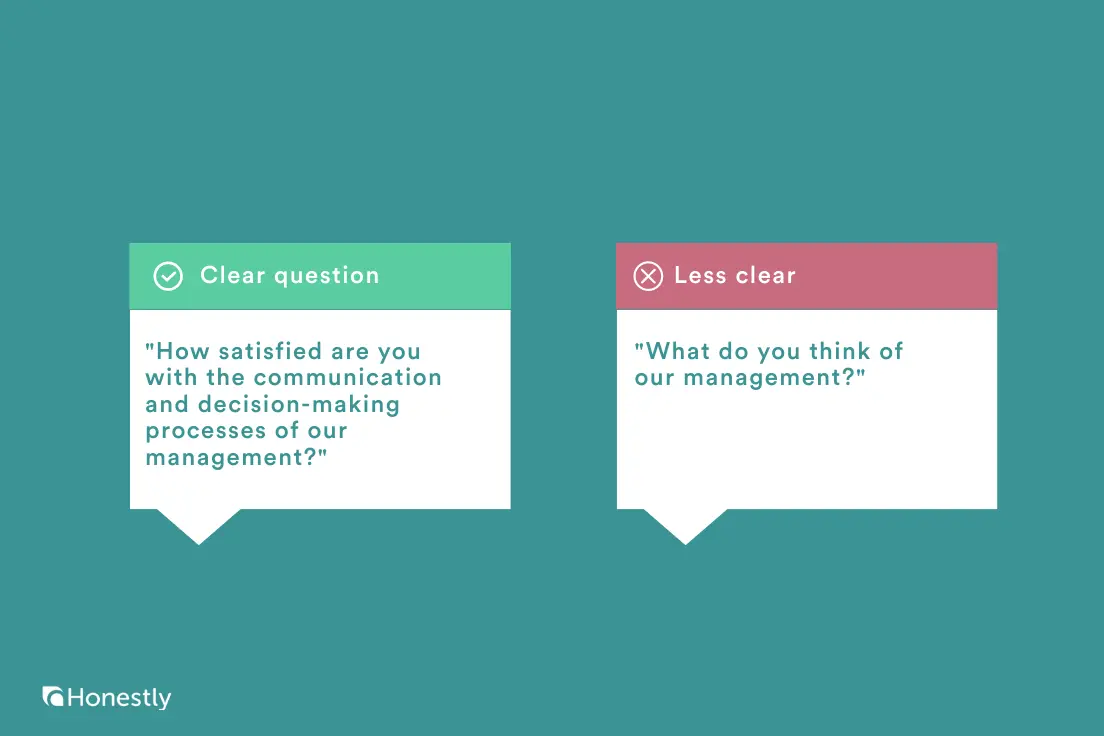
The Top 20 Employee Engagement Survey Questions
Below are some of the top employee engagement questions to include in your survey—based on our extensive research.
To access the full list of validated questions, check out Honestly’s employee engagement survey tool.
Survey questions about workplace climate and HR processes
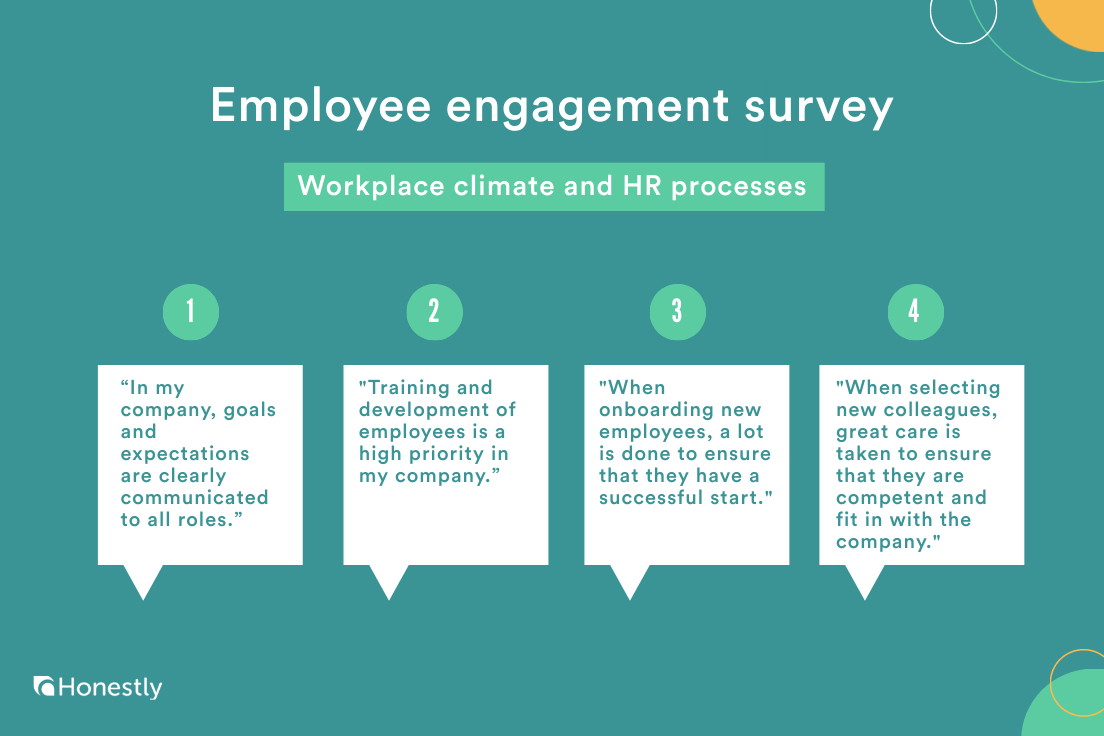
Start with questions about how team members interact day-to-day and the support they get from HR.
These questions cover topics like:
- Hiring practices
- Employee onboarding
- Training of existing employees
These sample questions are presented in the format of an Agreement Scale.
For example:
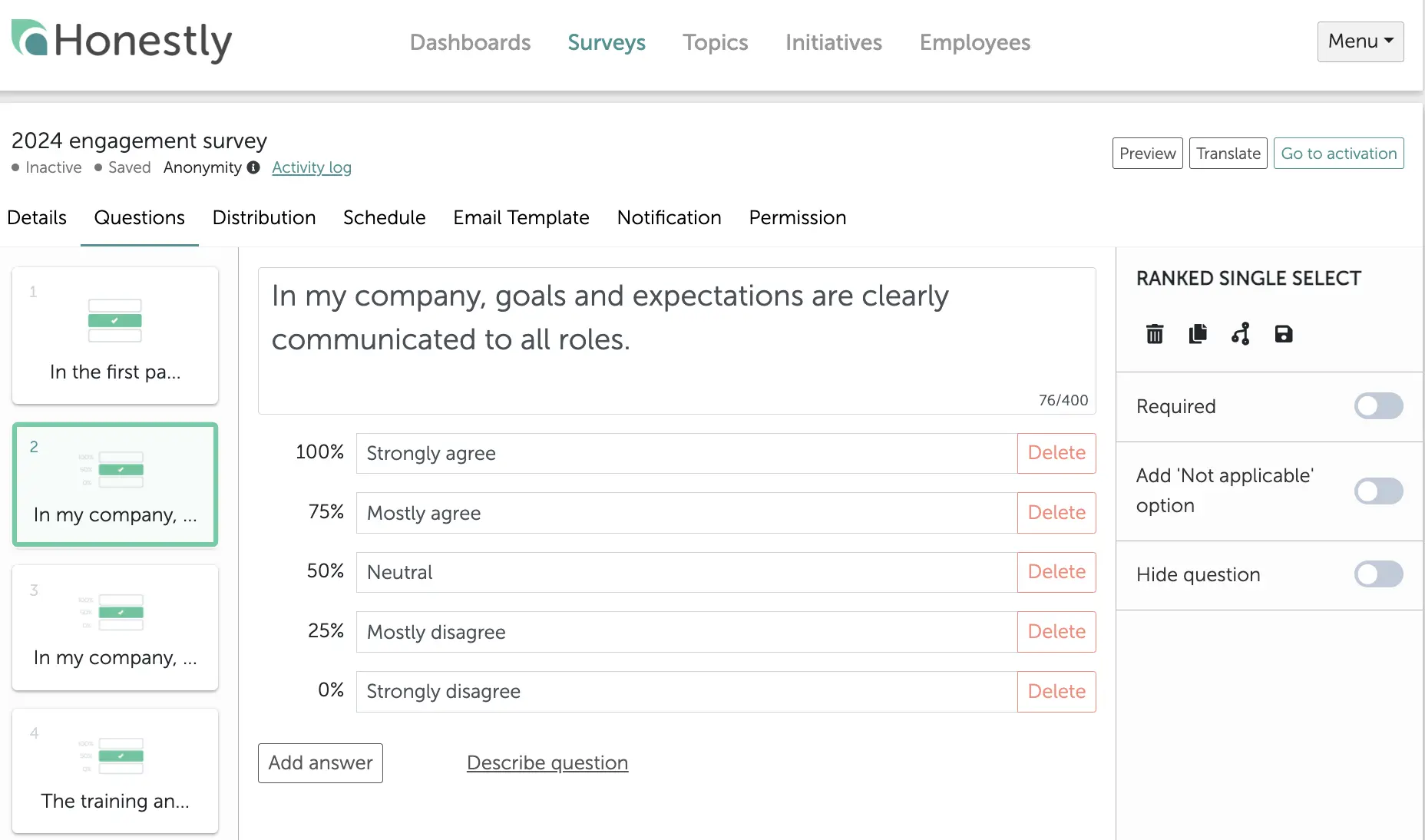
It allows respondents to express how strongly they agree or disagree with each statement, providing a clear quantitative measure of their views.
1. “In my company, goals and expectations are clearly communicated to all roles.”
This statement helps assess how effectively the company communicates its objectives and role expectations across all levels.
2. “In my company, employees with potential are actively promoted.”
Use this question to evaluate the company’s commitment to career progression and whether high-potential employees feel recognized and advanced.
3. “Training and development of employees is a high priority in my company.”
This question analyzes the emphasis placed on continuous learning and growth opportunities within the organization.
4. “When onboarding new employees, a lot is done to ensure that they have a successful start.”
Use this survey question to measure the effectiveness of the onboarding process, crucial for new hires’ long-term success and integration.
5. “When selecting new colleagues, great care is taken to ensure that they are competent and fit in with the company.”
This question looks at the recruitment process, focusing on the balance between skillset match and cultural fit.
Pro tip: Use Honestly to automatically include the full list of essential employee survey questions.
The tool features a scientifically proven survey model and unlimited dashboards for analyzing your survey results.
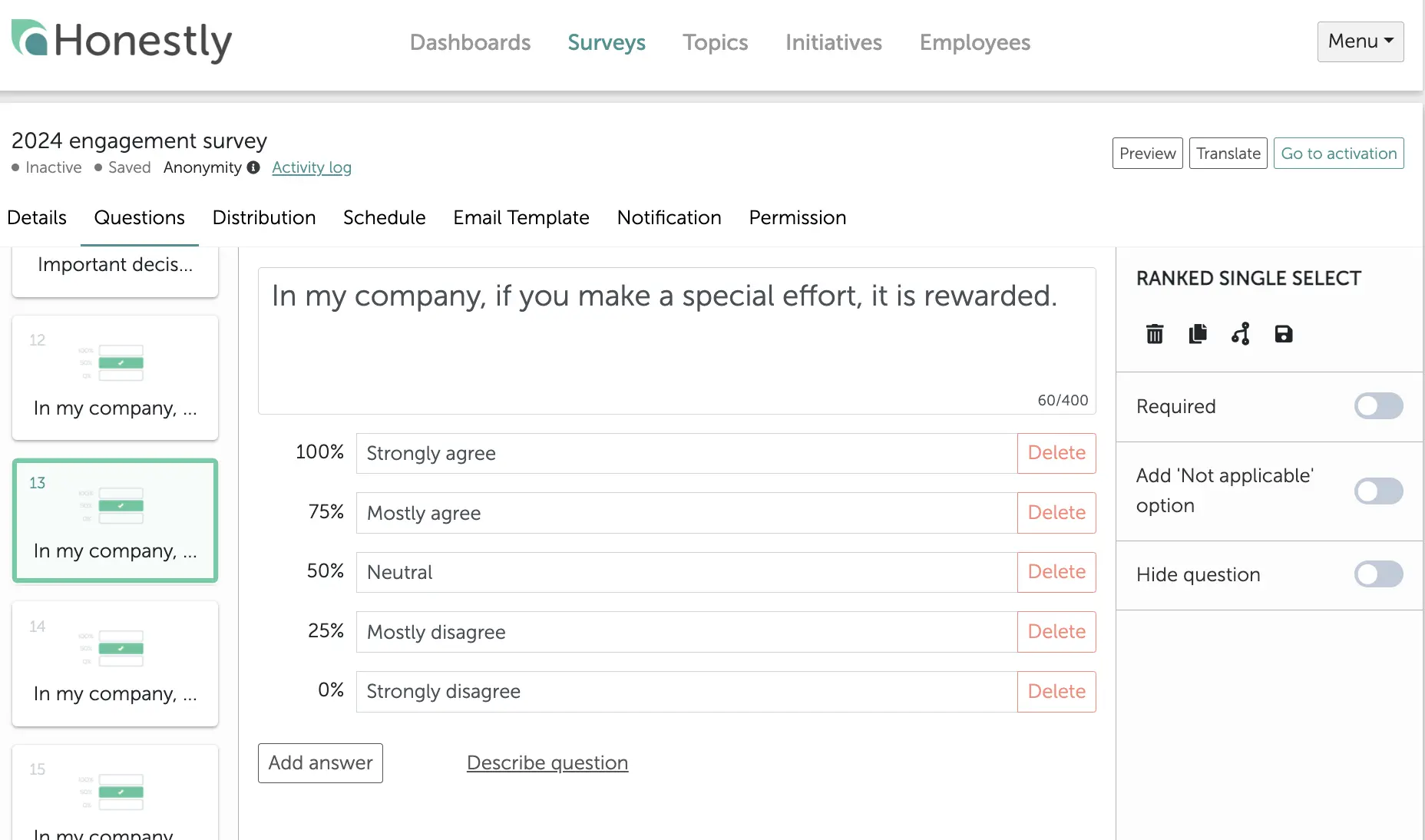
Survey questions about resources and demands
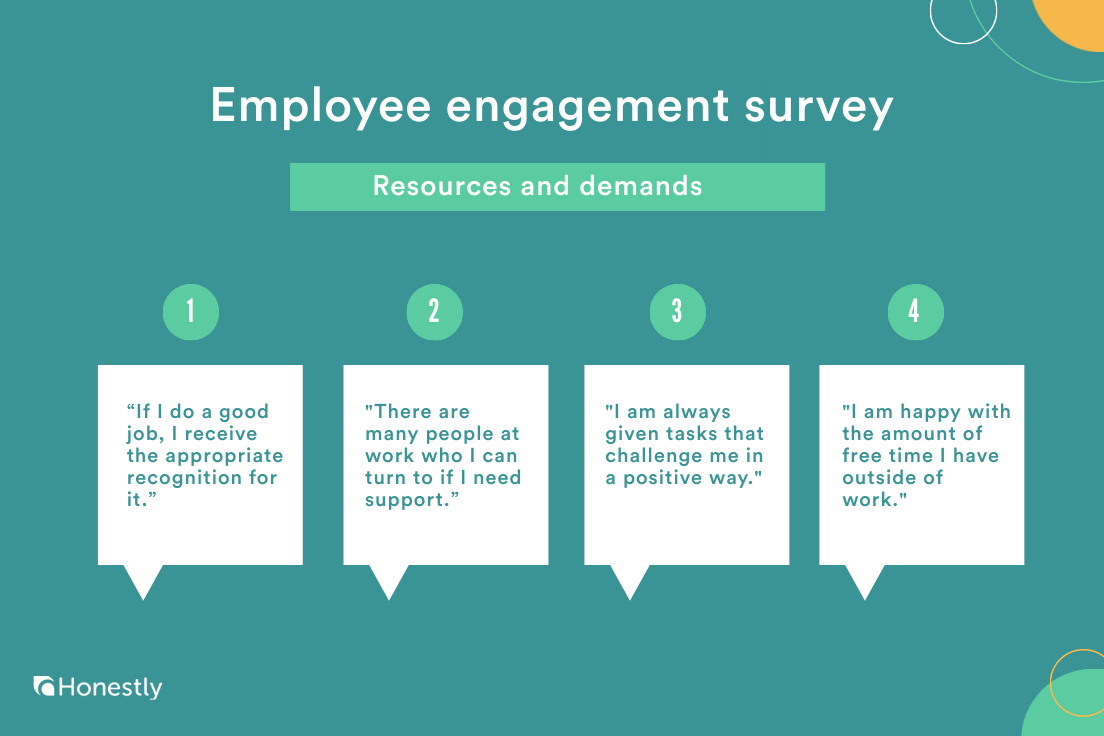
Next up, dive into questions about resources and demands in the workplace.
Balancing what employees have versus what’s asked of them is key to job satisfaction and overall well-being.
These questions explore areas such as:
- Recognition in the workplace
- Quality of relationships with colleagues and managers
- Variety and challenge in tasks
- Autonomy in work decisions
- Work-life balance
Start by asking about the “resources” available at work.
This focuses on the support, tools, and relationships that empower employees to perform their best.
6. “If I do a good job, I receive the appropriate recognition for it.”
This question assesses whether employees feel valued and rewarded when they perform well, which is essential for their job satisfaction.
7. “I receive constructive feedback from my manager on my performance at work.”
Feedback is critical for improvement; this question measures how effectively managers provide feedback that contributes to employee development.
8. “There are many people at work who I can turn to if I need support.”
This question looks at the availability of support systems within the organization, reflecting on the collaborative culture of the workplace.
9. “I am always given tasks that challenge me in a positive way.”
This survey question evaluates whether employees are stimulated by their work, which is important for engagement and growth.
10. “My workplace is equipped with everything I need to do my job well.”
This question checks whether the physical work environment supports your employees’ needs. This could include office facilities, tech tools they use, and so on.
Next, shift focus to the “demands” employees handle.
Here, you’ll explore the workload, stress, and emotional aspects of their roles.
11. “I can generally handle the amount of tasks I have to do.”
This question measures whether the workload is manageable, which can impact stress levels and overall performance.
12. “I am happy with the amount of free time I have outside of work.”
We can all agree that work-life balance is crucial for employee well-being; this statement evaluates satisfaction with the amount of personal time your employees have.
Employee survey questions about job satisfaction
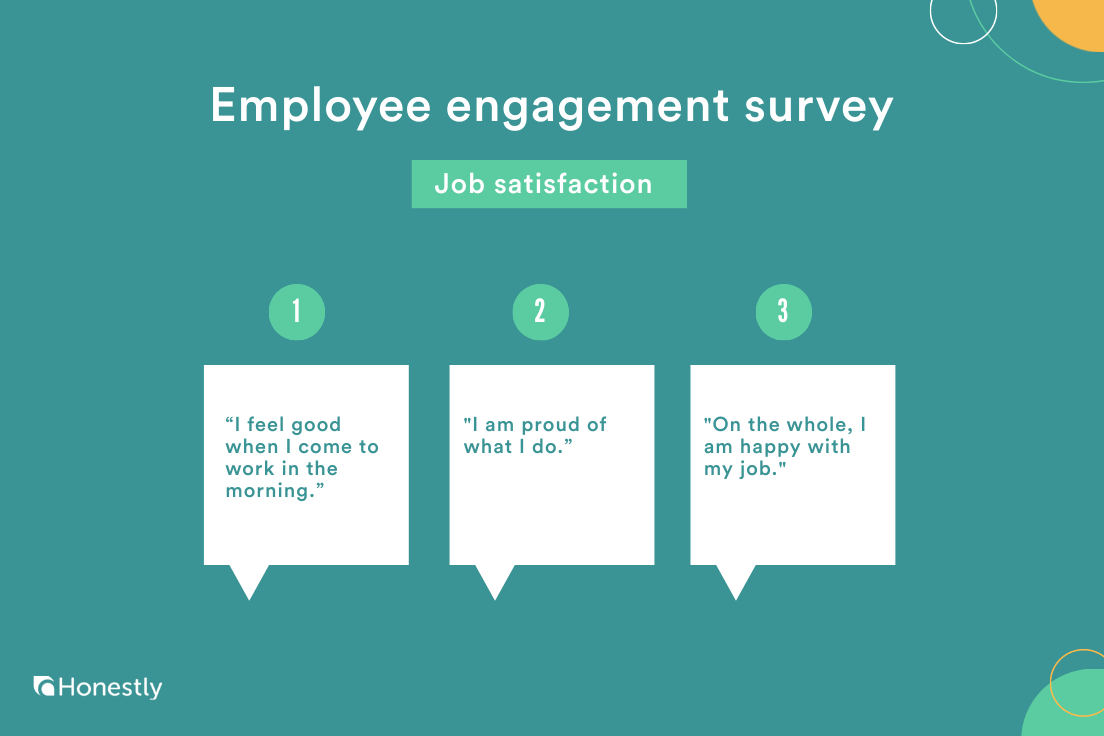
Next, move on to questions about job satisfaction.
They focus on understanding how your employees feel about their work and their level of motivation.
These questions aim to uncover:
- Overall job satisfaction
- Motivation levels
- Work experience quality
13. “I feel good when I come to work in the morning.”
This question taps into the overall mood of your employees as they start their workday. It’s a good indicator of their general satisfaction and enthusiasm for their job.
14. “I am proud of what I do.”
Asking this helps you understand if employees feel a sense of accomplishment and pride in their roles.
15. “On the whole, I am happy with my job.”
This question gives a broad view of job satisfaction among your team. It’s a straightforward way to measure if employees are content with their roles.
Survey questions about intention to leave and commitment
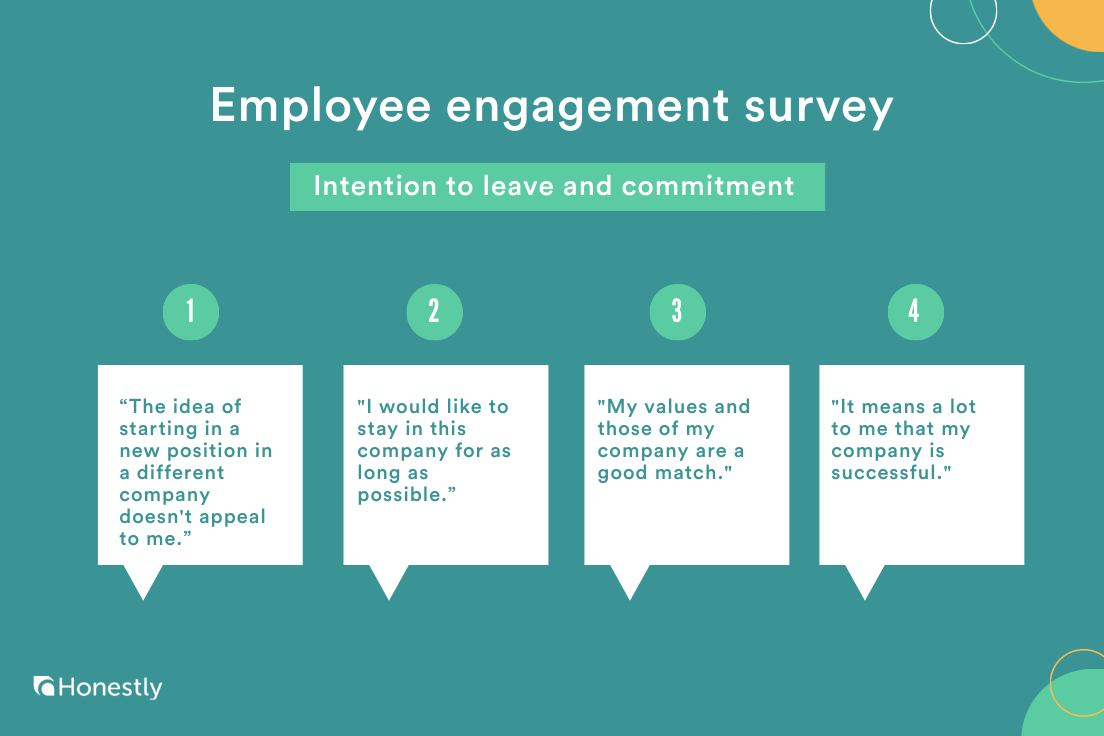
Wrap up with questions about your employees’ future intentions and organizational commitment.
It’ll help you assess whether they’re considering a move and how deeply they connect with your company’s goals.
These employee survey questions analyze:
- Potential job-seeking intentions
- Feelings of endorsement towards the company
- Sense of belonging and eagerness to contribute
16. “The idea of starting in a new position in a different company doesn’t appeal to me.”
This question helps you understand whether your employees are loyal to your company and satisfied with their work.
17. “I would like to stay in this company for as long as possible.”
This question directly assesses whether your employees wish to remain with the company.
18. “My values and those of my company are a good match.”
This one looks at the alignment between personal and organizational values, which is crucial for long-term engagement.
19. “It means a lot to me that my company is successful.”
This is an important indicator of your employees’ sense of belonging and pride in being part of the team.
20. “How likely are you to recommend your company to your friends and family as a place to work?”
Finally, you can also ask your employees whether they’d recommend your company as a workplace.
This employee Net Promoter Score is a powerful indicator of whether they’re happy and satisfied with their workplace.
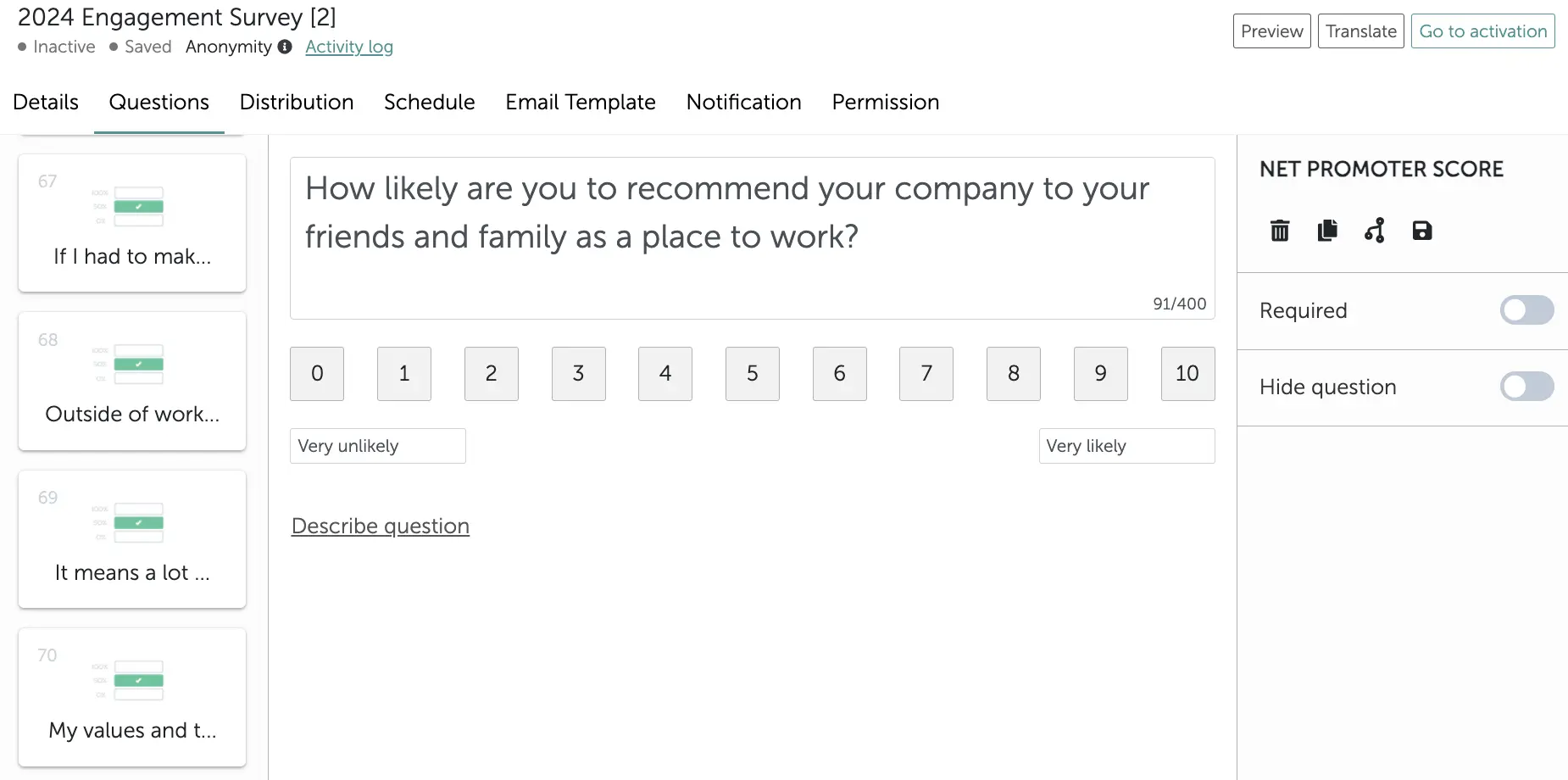
How to Conduct Effective Employee Engagement Surveys
Rolling out employee surveys is a strategic move towards building a stronger, more connected workplace.
Here are five key steps and tips to guide you through preparing and conducting an impactful employee engagement survey.
1. Start with Clear Goals in Mind
Before you launch your survey, pinpoint exactly what you want to learn.
Are you checking in on overall satisfaction, digging into specific areas like workplace climate, or tracking the effectiveness of recent changes?
For instance, if you want insights on how remote work affects team dynamics, focus your questions on collaboration, communication, and work-life balance.
2. Choose the Right Survey Tool and Model
Not all survey questions are created equal.
The effectiveness of your research will directly depend on the quality of your questionnaire.
You can tackle this by getting a specialized survey platform like Honestly.
It uses a scientifically validated model to generate questions that really get to the heart of employee engagement.
Use its ready-to-go templates to run effective surveys—saving time and ensuring great results.
Honestly also lets you benchmark your survey results against industry standards—providing a clear view of how you compare with companies of similar size and sector.
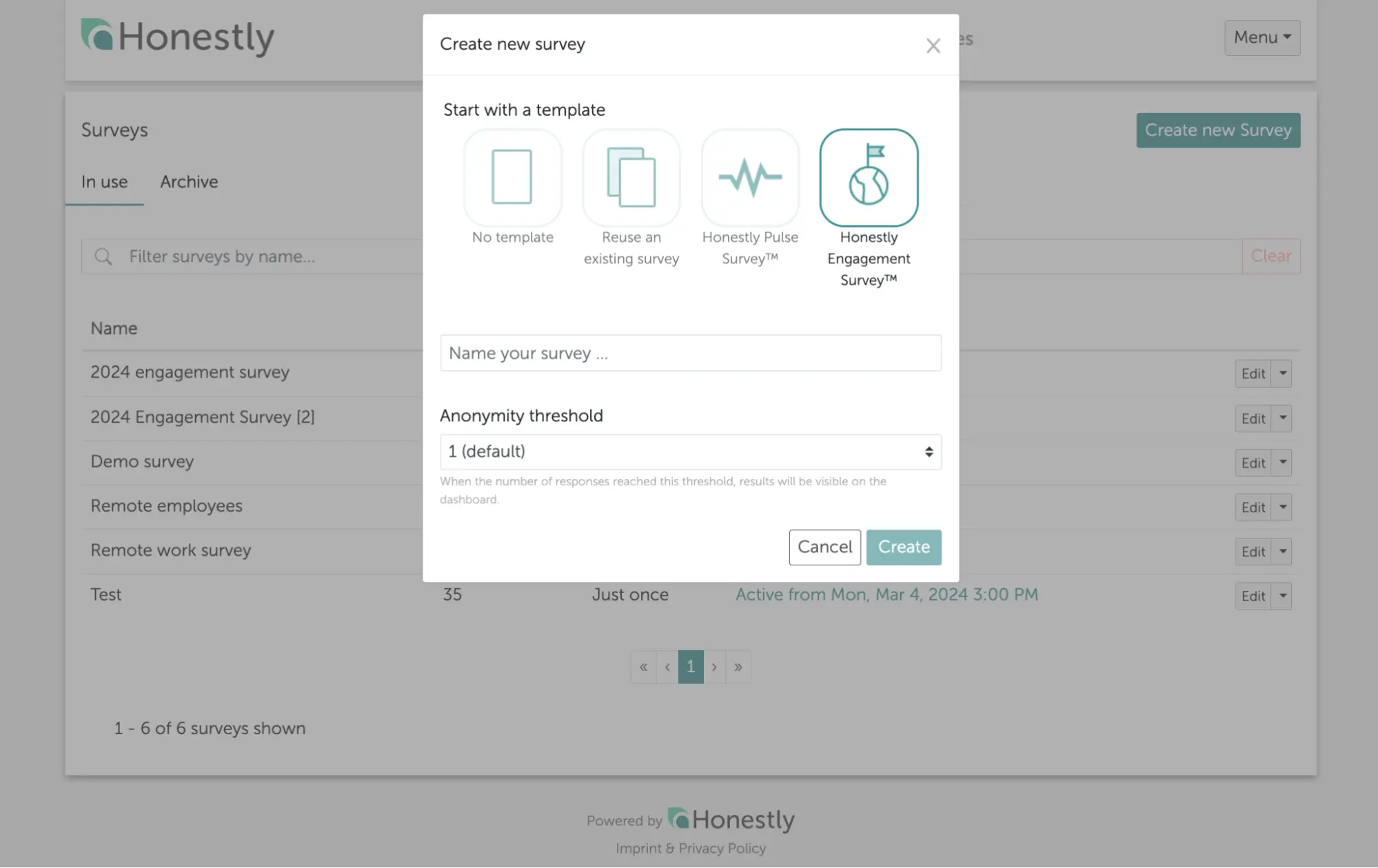
3. Design Your Questions Wisely
The way you ask is as important as what you ask.
Avoid leading or loaded questions that might skew the results.
Instead, opt for clear, concise questions that leave no room for misunderstanding.
For example:
Effective and clear questions:
- “How aligned do you feel with the company’s mission and values in your daily work?”
- “Do you feel aligned with our company culture and values?”
- “Do you feel that your work contributions are recognized by the management?”
Not so effective and clear:
- “Do you like working here?”
- “Do you think our company has a good workplace culture?”
- “Do you feel recognized at work?”
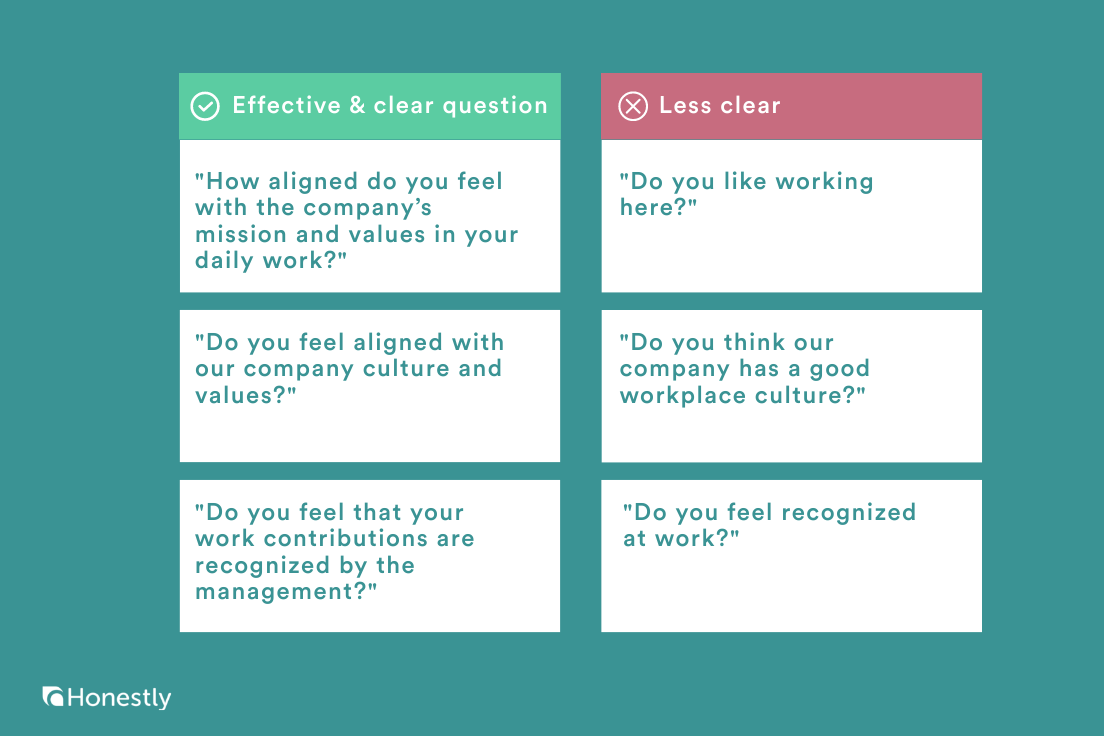
4. Analyze and Act on the Feedback
Gathering data is just the start.
The real magic happens when you analyze the responses and use them to make informed decisions.
That’s why it’s key to have a powerful data analysis tool at your disposal.
If you’re using Honestly, make sure to try its unlimited dashboards.
They let you slice and dice the data to find patterns, track changes over time, and pinpoint areas for improvement.
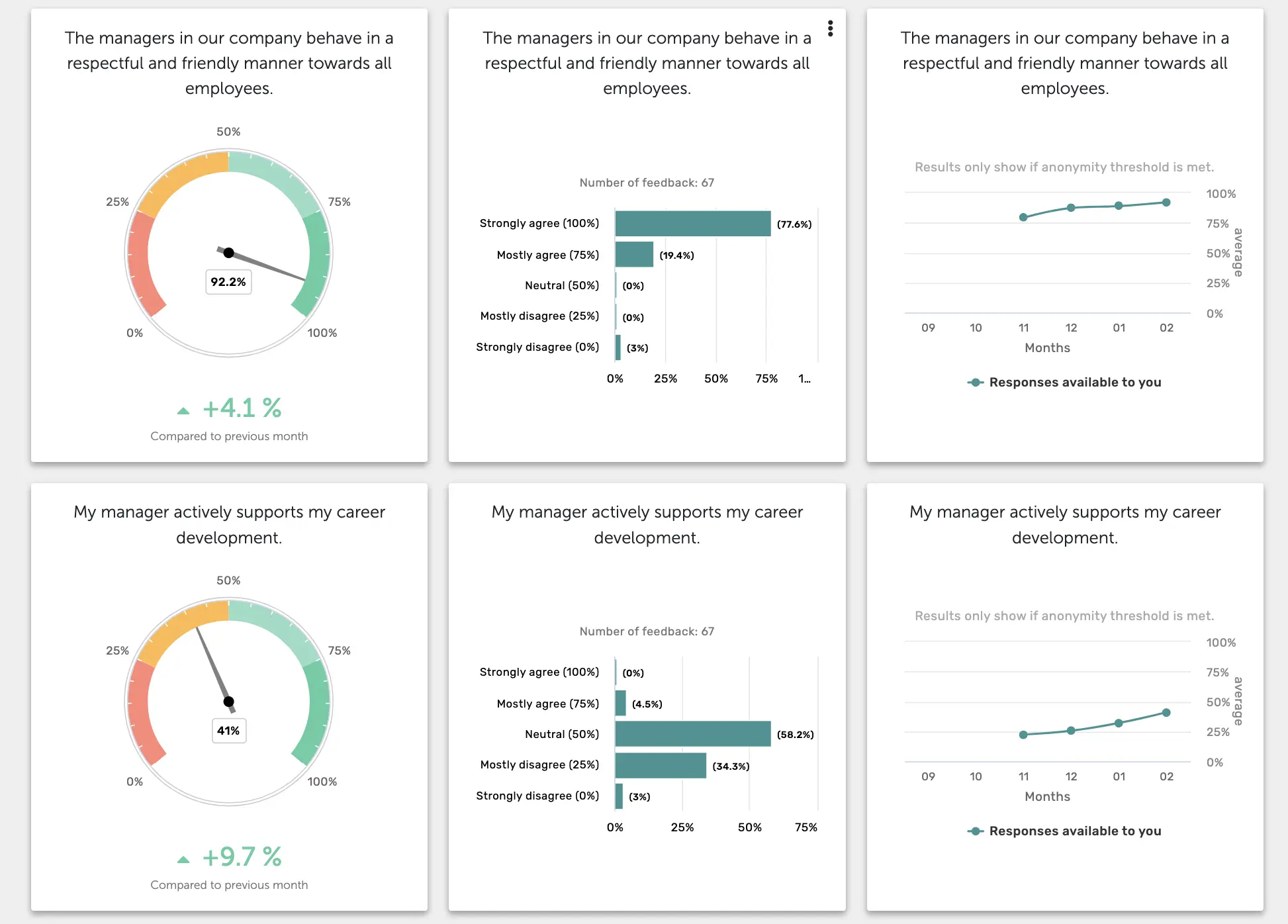
Did you know?
If you include open-ended questions in your survey, the tool’s powerful AI will analyze them for you and generate descriptive summaries.
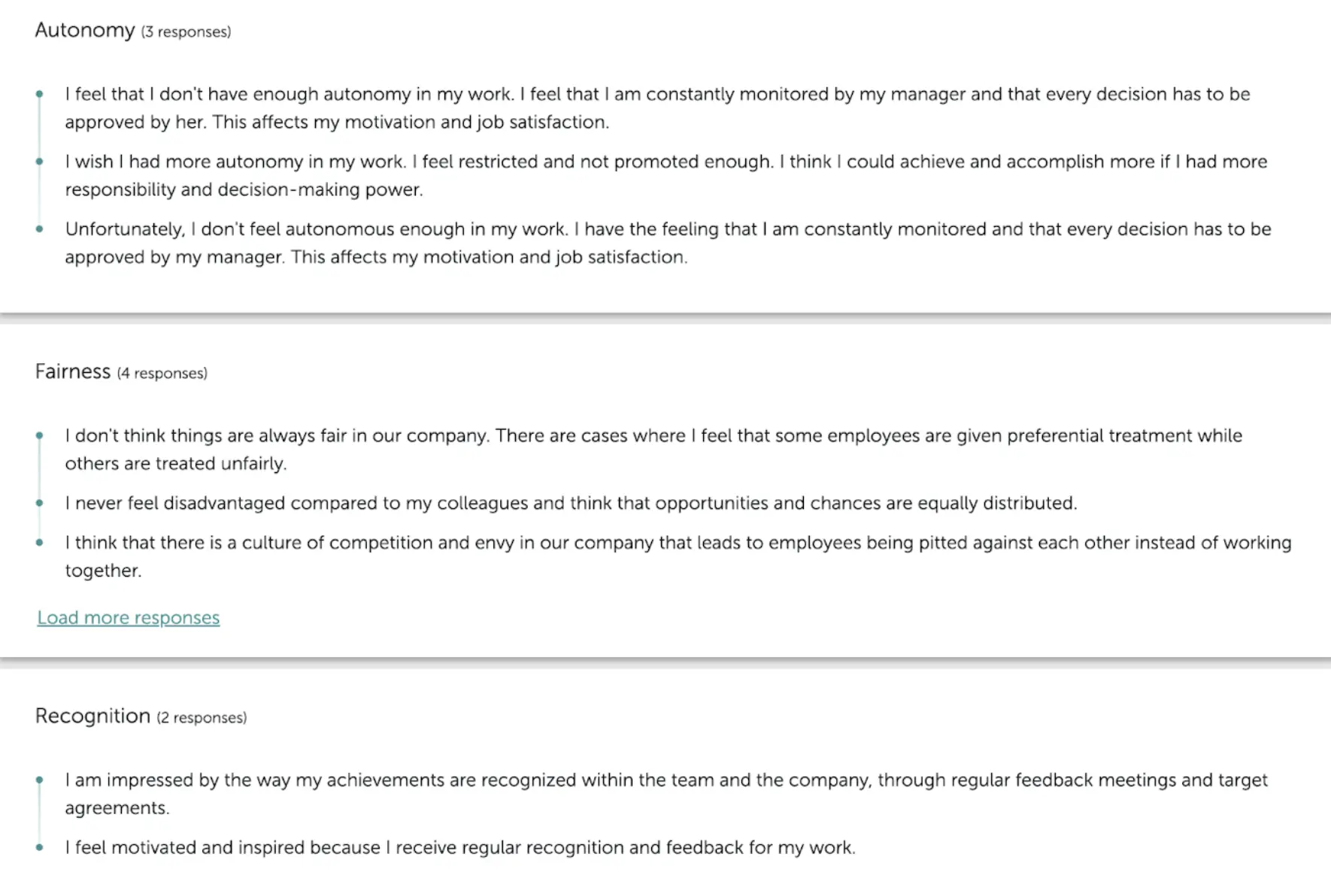
5. Follow Up and Keep the Conversation Going
Your employee engagement surveys shouldn’t be one-off events.
Regular follow-ups, like pulse surveys, keep you in tune with your team’s evolving sentiments.
This continuous dialogue shows employees you’re listening and committed to making changes.
For example, after implementing a new flexible working policy, a quick pulse survey can assess its impact and effectiveness, allowing you to adjust as needed.
Use Honestly’s pulse survey template to automate this step.
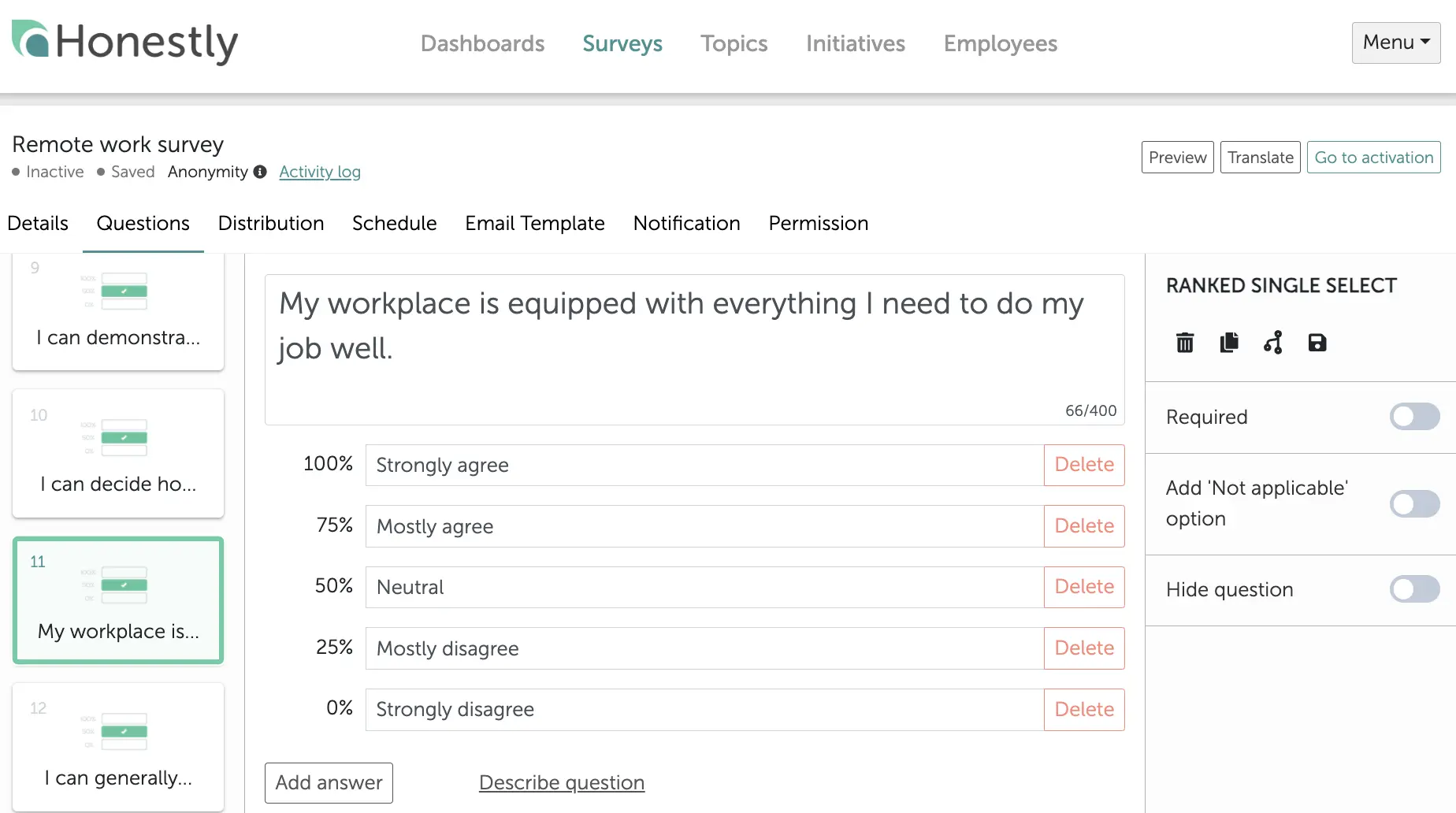
Then, make sure to analyze your results dynamically and look for patterns.
For example:
- Is there a positive or negative trend?
- Did the changes you introduced help improve the situation?
- Are there outliers in certain departments or locations?
Try Honestly’s trend charts and heatmaps to quickly generate and examine those insights.
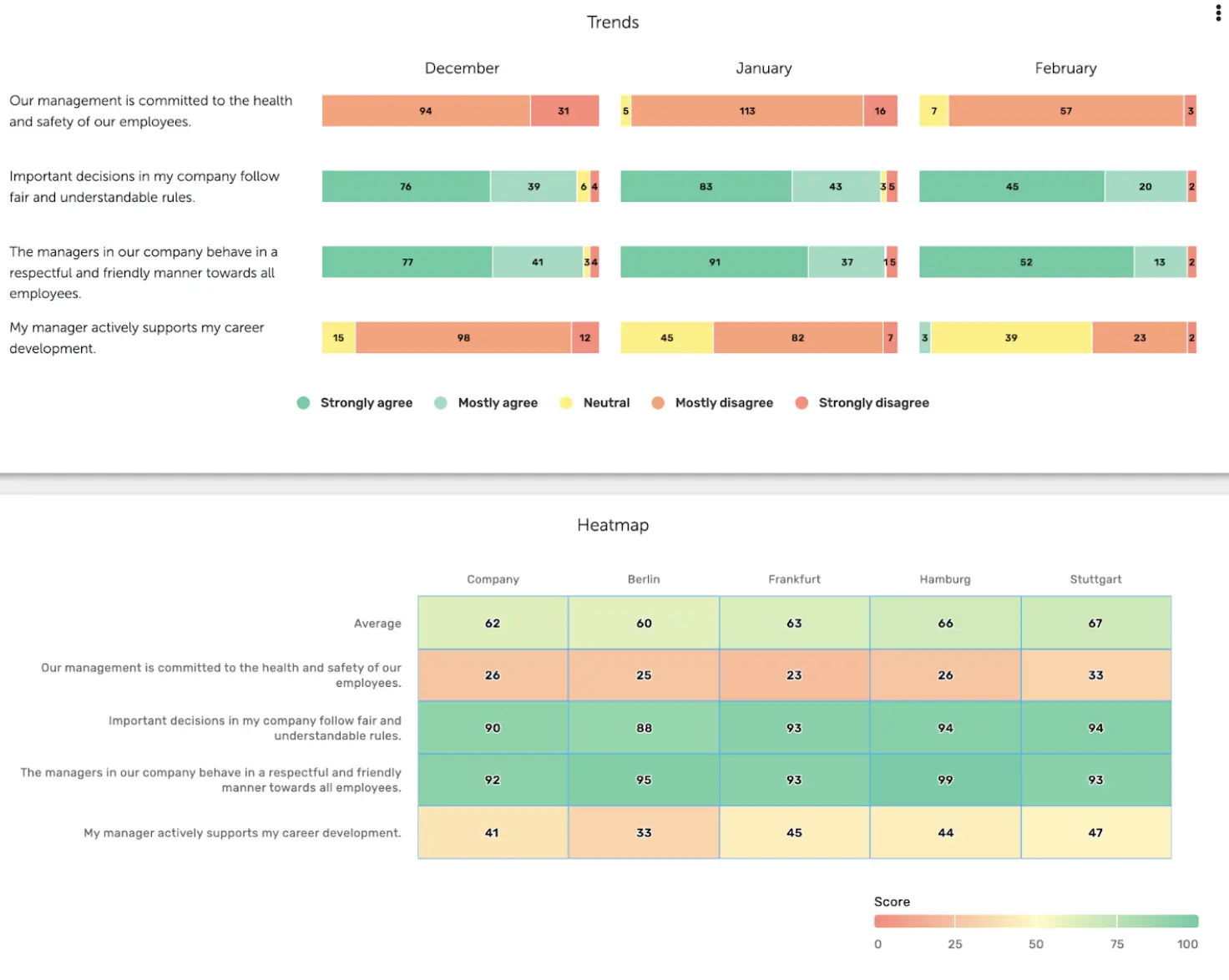
Wondering how to act on your survey insights? Honestly also provides a detailed handbook packed with actionable tips for building your employee engagement strategy.
Final Thoughts
Creating effective employee surveys is key to unlocking valuable insights into your team’s engagement and satisfaction.
By focusing on precise, actionable survey questions and using tools like Honestly, you can get to the heart of your team’s needs.
Your goal is to listen, understand, and take action based on what you learn—building a positive workplace culture.

